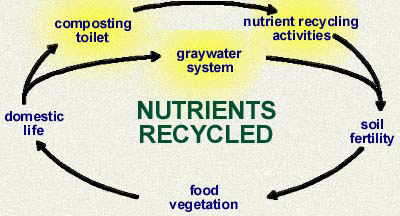| |
|
|
| |
|
| |
|
| Mike Merkle,
John Logan (2003) |
|
| Scott
Melbourne, Craig Skipton, Caroline Salisbury (2002) |
|
| Ayako Harada
and Emily Rivers (2001) |
|
| |
|
| Introduction |
|
| Greywater systems reuse non-fecal
water for irrigation of landscape plants on a residential scale.
The initial cost and installation of a Greywater System may
be high, however over time the amount of water used and the
amount of water returning to wastewater treatment facilities
will diminish and reduce water bills. A Greywater system can
be designed based on the layout of a site and the amount of
users and their needs. |
|
| |
|
This is important
because nitrogen is one of the hardest and most dangerous pollutants
to remove from usable water supplies. As seen in Figure 2, the
amounts of Nitrogen (N) are much greater in blackwater compared
to greywater, the time and energy to remove N form the water
becomes much greater, way then mix the two when only one type
needs to be cleaned. Greywater as well contains far fewer pathogens
then blackwater. That is a direct result of the absence of human
waste within greywater. As well the small amounts of organic
material that are in greywater decompose far faster than the
amounts that are in blackwater, and the BOD is far less in greywater.
This creates a situation where greywater can be cleaned and
filtered faster and with less effort than black water (Figure3).
In the face of these facts it is now seen that greywater can
be used and recycled for other uses. Greywater systems as a
whole can help to create a more sustainable life and return
water and nutrients to the environment.
|
|
| |
|
The
sources of greywater are varied. But they all fall into one
of two categories: recycled or reclaimed. Recycled water refers
to water that has already been used by humans and has been kept
free of contamination from blackwater sources. Some examples
of recycled water are bath water, bathroom sink water, some
kitchen water, and washing machine water. Reclaimed water refers
to the captureing of new water that has not yet been used by
humans.
|
 |
|
| |
|
| The
most common type of water reclamation is the collecting of rainwater
for human use. The following discussion will focus on the application,
components involved, and case studies of systems for both of
these sources of greywater. |
|
| |
|
| |
|
| |
|

